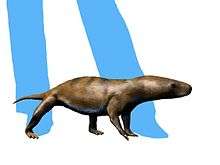Chiniquodon
| Chiniquodon | |
|---|---|
| Fossil of C. theotonicus in the Museum of Paleontology, Tuebingen | |
| Scientific classification | |
| Kingdom: | Animalia |
| Phylum: | Chordata |
| Order: | Therapsida |
| Suborder: | Cynodontia |
| Family: | †Chiniquodontidae |
| Genus: | †Chiniquodon von Huene, 1936 |
| Species | |
|
C. brasilensis | |
| Synonyms | |
| |
Chiniquodon is an extinct genus of carnivorous cynodonts, which lived during the early Middle Triassic in South America and Madagascar. Chiniquodon is closely related to a contemporary genus, Probelesodon, and close to the ancestry of mammals.
Other contemporaries included early dinosaurs. As both groups filled a similar ecological niche, fairly large therapsid hunters such as Chiniquodon may have been outcompeted by dinosaurs.
Classification


Chiniquodon brasilensis is from the Paleontological Site Chiniquá, Santa Maria Formation, Brazil, in geopark of paleorrota. Age: Carnian, Upper Triassic Remarks: A dog-sized predator, with a skull-length of about 10 centimetres (0.33 ft). This species may not have been formally published.
Chiniquodon sanjuanensis[1] is from the Ischigualasto Formation, Argentina. Age: Carnian (Upper Triassic) This skull was reassigned to this genus in 2002.[2] It's differentiated from Chiniquodon theotonicus because of its teeth and the shape of the zygomatic process.
Chiniquodon theotonicus Is from Santa Maria Formation and Chañares Formation, Brazil and Argentina. Carnian (Upper Triassic) This species is known from a number of skulls. The holotype is in the paleontological collection at Tübingen University, Germany.
Chiniquodon kalanoro[3] is from the Makay Formation, Madagascar. Age: Ladinian/Carnian (Middle/Upper Triassic) This species is known from a mandible (holotype UA 10607).
References
- ↑ Ricardo N. Martinez & Catherine A. Forster (June 1996). "The skull of Probelesodon sanjuanensis, sp. nov., from the Late Triassic Ischigualasto Formation of Argentina". Journal of Vertebrate Paleontology. 16 (2): 285–291. doi:10.1080/02724634.1996.10011315.
- ↑ Abdala, F.; Giannini, N. P. (2002). "Chiniquodontid cynodonts: systematic and morphometric considerations". Palaeontology. 45 (6): 1151–1170. doi:10.1111/1475-4983.00280.
- ↑ Christian F. Kammerer; John J. Flynn; Lovasoa Ranivoharimanana; André R. Wyss (2010). "The first record of a probainognathian (Cynodontia: Chiniquodontidae) from the Triassic of Madagascar". Journal of Vertebrate Paleontology. 30 (6): 1889–1894. doi:10.1080/02724634.2010.520784.
Further reading
- Von Huene. Die Fossilien Reptilien des südamerikanischen Gondwanalandes an der Zeitenwende (Denwa-Molteno-Unterkeuper = Ober-Karnisch). Ergebnisse der Sauriergrabungen in Südbrasilien 1928/29. (The fossil reptiles of South American Gondwana during the temporal transition) (Denwa-Molteno-Upper Triassic = Upper Carnian). Results of the excavations in South Brazil 1928/29, part II.) 1936. Pages 93–159.